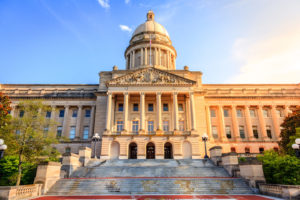Legislature’s veto override means charter schools could soon open in Kentucky
(reimaginED) – An override of Gov. Andy Beshear’s veto Wednesday night could clear the way for charter schools to open in Kentucky, five years after they were made legal in the Bluegrass…

(reimaginED) – An override of Gov. Andy Beshear’s veto Wednesday night could clear the way for charter schools to open in Kentucky, five years after they were made legal in the Bluegrass State.
The House voted 52-46 to send House Bill 9, sponsored by House Majority Whip Chad McCoy. The Senate later voted 22-15 to override Beshear’s veto, making the measure law.
Kentucky is one of six states that allows its legislature to override a veto with a simple majority vote in both houses, which Republicans currently control.
HB 9 would provide a permanent funding mechanism for charter schools by allowing state and local funding allocated to district schools to follow the student if the student enrolls in a charter school.
It also provides charter school pilot programs in Louisville and northern Kentucky.
Lawmakers approved charter schools in 2017, but none have opened because no funding stream was approved. HB 9, sponsored by McCoy, R-Bardstown, was an attempt to remedy that.
McCoy said the locations for the pilots were chosen based on the greatest need. He agreed with a group of faith leaders who supported HB 9 and said, “we are failing the minority kids in the West End of Louisville when it comes to education.”
“My hope is that if we run a pilot project, maybe we can get one there that show the rest of the state there’s nothing to be afraid of, these things are going on all over the country, and they’re not going to hurt public schools,” he said during a March 23 debate.
(You can listen to a reimaginEDonline podcast of McCoy talking about the successful override of Beshear’s veto of a 2021 bill that established an income-based education savings account program here.)
The override of HB 9 came nearly a week after Beshear announced his veto at a news conference.
“I’m against charter schools,” Beshear, a Democrat, told reporters as he fulfilled an earlier pledge to veto the bill, which initially passed both chambers by thin margins. Beshear called charter schools, which are publicly funded but privately operated, “wrong for our commonwealth.”
Echoing the criticisms of opponents and teachers’ unions, Beshear said, “they take taxpayer dollars away from already underfunded schools.” He added that the bill would likely be found unconstitutional if challenged in court.
The Network for Public Education, a national group that opposes charter schools, has promised to file a lawsuit. But supporters of charter schools and education choice praised the new law as a victory for families.
“We appreciate the legislators, who, with their vote finalizing the funding of public charter schools in the commonwealth, rejected the fearmongering displayed throughout this debate opponents of school choice,” the Bluegrass Institute said in a statement issued shortly after the vote.
“Kentucky’s parents will now have access to these innovative public schools just like families in 44 other states including our neighboring states —and the District of Columbia.”
Todd Ziebarth, senior vice president of advocacy and support for the National Alliance of Public Charter Schools, called equitable funding for charters “essential” and said, “We are thrilled that Kentucky is finally providing charter school students with the funding they deserve.”
According to the organization, charter schools serve underserved communities and do an exceptional job. Data show almost 70% of charter school students are students of color compared to about 53% of district school students.
A study by Stanford University’s Center for Research on Education Outcomes found that in urban charter schools, low-income Latino students gained 48 additional days in math and 25 additional days in reading per year, while low-income Black students gained 44 additional days in reading and 59 additional days in math per year.
This article originally appeared at reimaginED.



